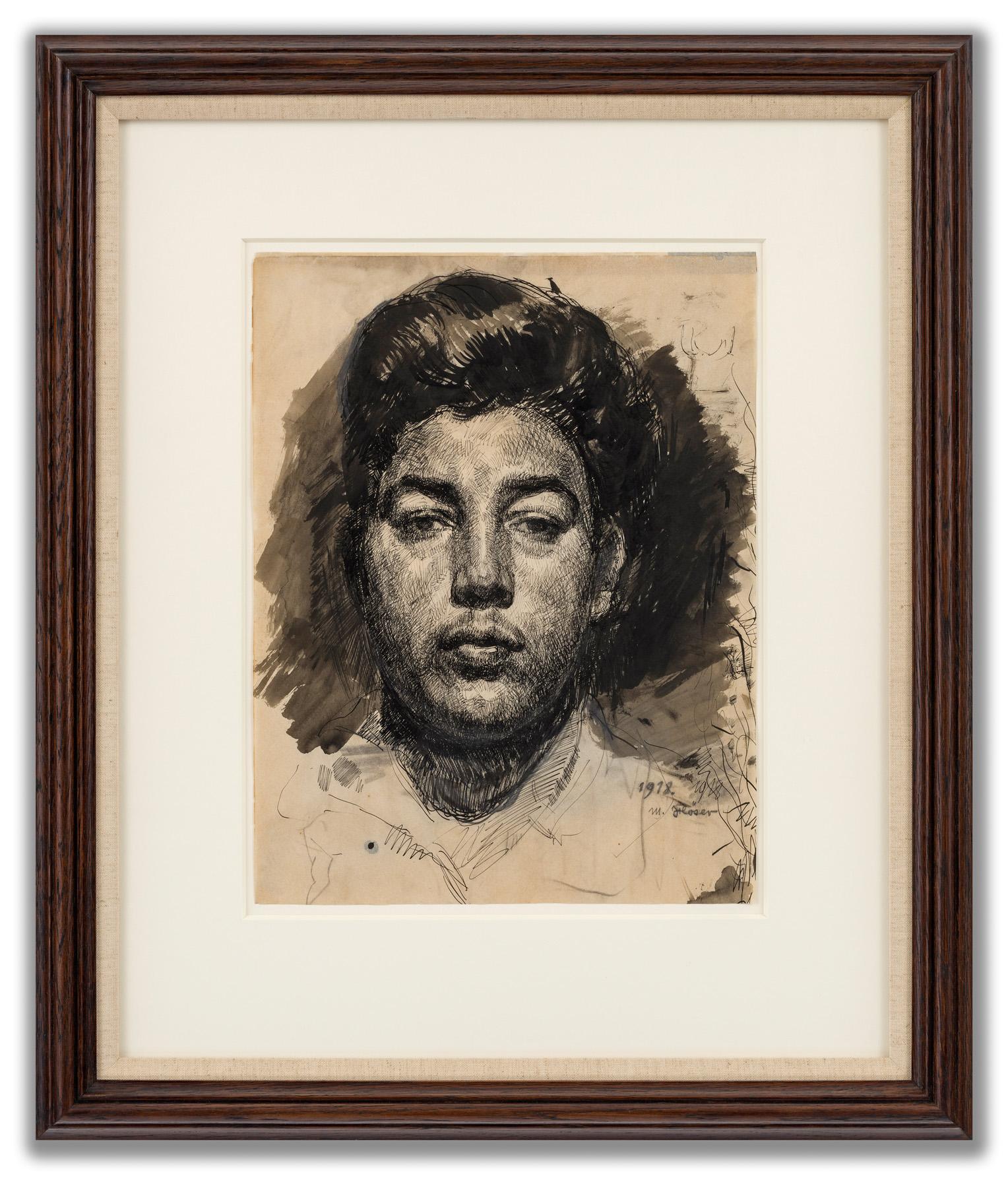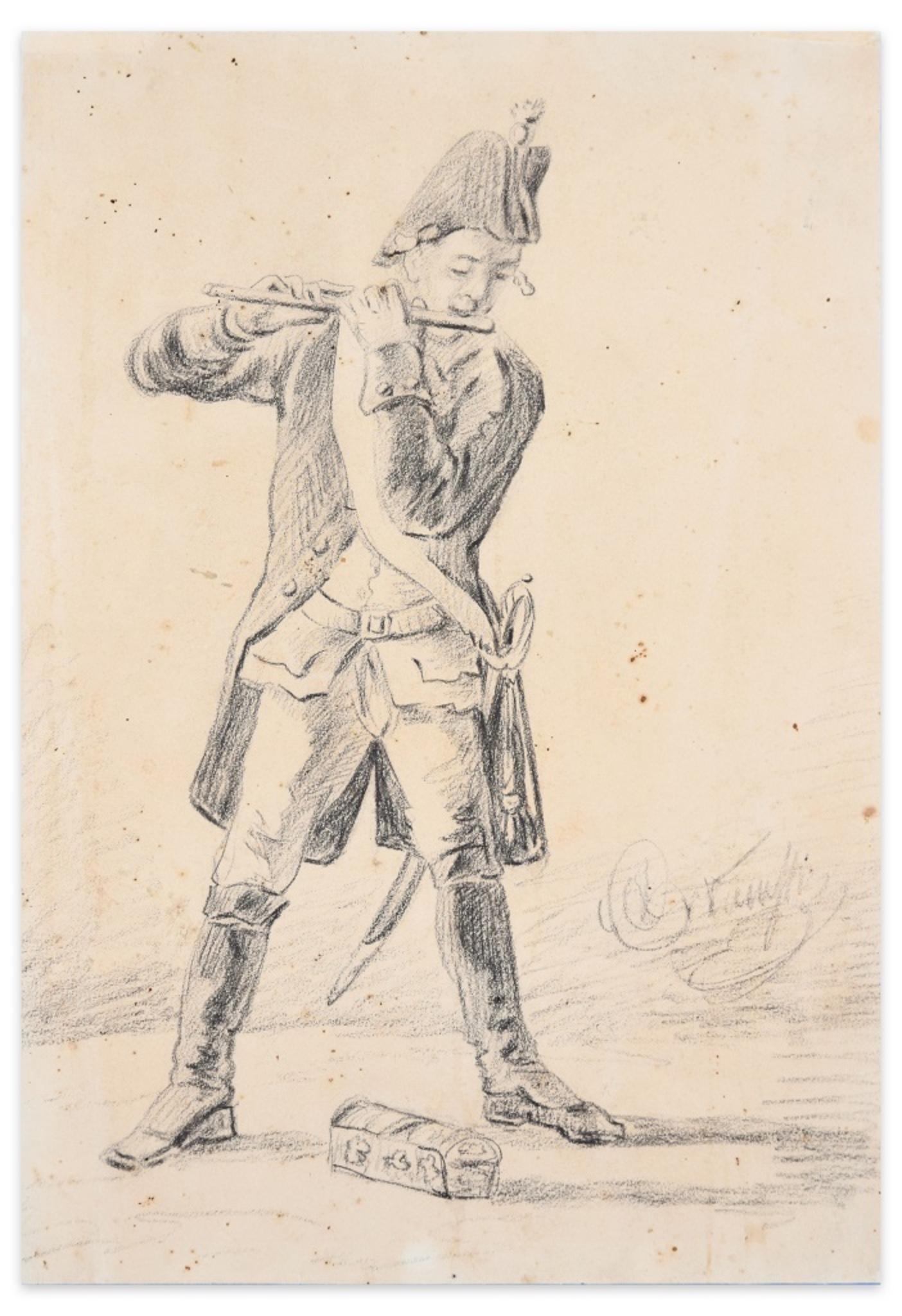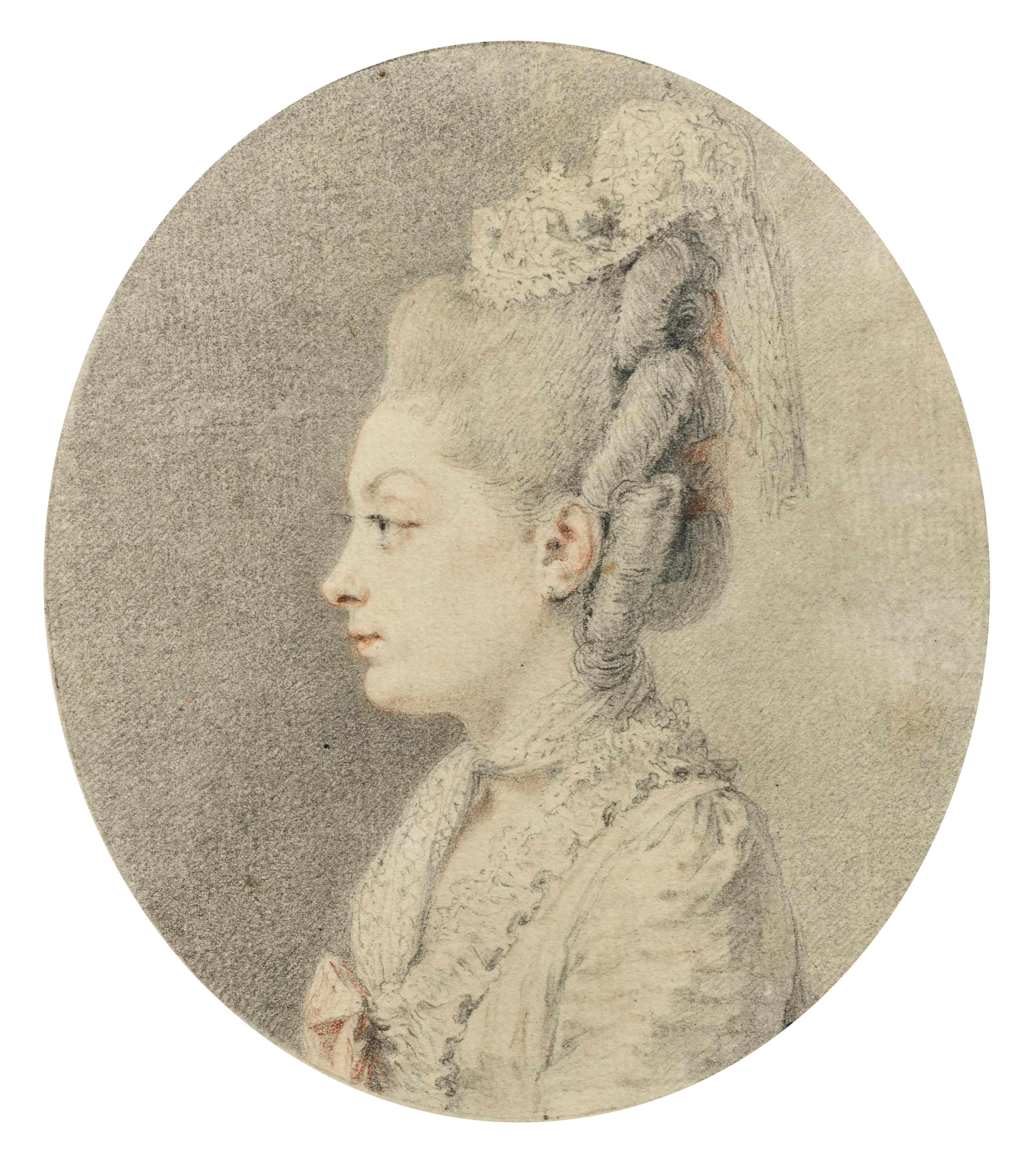Items Similar to The Arab Butcher, a preparatory drawing by Gustave Guillaumet (1840 - 1887)
Want more images or videos?
Request additional images or videos from the seller
1 of 11
Gustave GuillaumetThe Arab Butcher, a preparatory drawing by Gustave Guillaumet (1840 - 1887)circa 1865
circa 1865
About the Item
This intensely expressive figure is a preparatory study for "Arab Market on the Tocria Plain", a painting exhibited at the 1865 Salon and now in the Musée des Beaux-Arts in Lille.
1. Gustave Guillaumet, a "Saharan" painter with a passion for Algeria
Gustave Guillaumet was born into a family of industrialists; this affluence allowed him to be financially independent throughout his life, which was quite rare in the artistic circles of the time. A student of François Edouard Picot (1786-1868) and Félix-Joseph Barrias (1822-1907) at the Ecole des Beaux-Arts in Paris, Gustave Guillaumet exhibited his paintings at the Salon from 1861 to 1880. He differed from most other Orientalist painters by his deep knowledge of the Orient, and more specifically of Algeria, which he discovered in 1862. He left for Italy after failing at the Prix de Rome in 1861, but the bad weather on his way encouraged him to take a boat to Algeria in Marseille.
Despite the malaria he caught there, which forced him to spend three months at the military hospital in Biskra, he returned enthusiastic about this country, where he went back a dozen times. He was the only painter to visit the extreme south of Algeria at that time, and particularly the Laghouat region, on the edge of the Sahara, which he discovered in 1877.
As François Mouquin wrote in 2018 in the catalogue of the exhibition devoted to Guillaumet: "his painting was not a simple genre painting. It was the portrait of a culture, that of Algeria, whose light he was able to master marvellously. He translated those customs, those traditional activities and the patriarchal life of this thousand-year-old civilisation, in a way which was better than any other could have done and equivalent to that of an ethnologist."
Guillaumet died at the age of forty-seven on 14 March 1887 in his studio located at 5 Cité Pigalle. He was buried in the Montmartre cemetery, where his grave has been decorated with a sculpture by Louis Barrias (the brother of his teacher at the Beaux-Arts) depicting a seated young Algerian woman.
2. The Arab market on the Tocria plain (5th picture in the gallery)
This vast painting (211 x 342 cm) was exhibited at the 1865 Salon, alongside Evening in the Sahara, south of Bou-Saâda, another Saharan genre scene depicting a caravan stopover (whereabouts unknown). Placed under a zenithal sun, this Market was presented in opposition to a twilight view.
This market scene evokes an essential aspect of life for the semi-nomadic populations of southern Algeria. Its location probably refers to Ain Tokria, an archaeological site in the commune of Khemisti on the Sersou plateau (some 100 km as the crow flies from the coast, between Algiers and Oran). Still rather inhospitable at the time, this region of extensive farming and cattle-raising was a major strategic zone between the Tell and the Saharan Atlas. The motif was probably also inspired by the large market held a little further east, in the Boghar region (Ksar el Boukhari), which was an important trading place where shepherds and farmers were purchasing cereals, dates, wool and sheep.
The frieze composition featuring hieratic figures camped in a desert landscape is typical of the artist's work. In this arid environment, crushed by the meridian light, the artist develops a restricted chromatic range - the off-white of the burnous, the ochres of the earth, the azure of the sky - enhanced by a few touches of vivid color.
These two paintings, which represent a "pacified" vision of the "natives" of the Southern Territories, were well received at the 1865 Salon (one was bought by the Beaux-Arts department, the other by the Emperor with his civil list) and exhibited at the 1867 Universal Exhibition. Guillaumet took up the same subject again in 1877 , radically renewing the composition with the addition of female figures, absent from our first painting.
The study we are presenting is part of a rather large corpus of drawings and painted studies documenting not only the Sersou landscape, but also every figure, every gesture, and every group in the painting, as in this study of a Young Bedouin (for the figure in the foreground, in the center of the composition - last photo in the Gallery).
The Arab butcher (6th picture in the gallery), on the left of the composition, is much smaller in the painting than in our study, demonstrating the artist's care in preparing the smallest details of his composition.
The painted depiction of our butcher differs little from the preparatory study we present, except in the position of the tripod used to display the pieces of meat on which he nonchalantly rests his left wrist, a tripod which is located behind his legs in this preparatory study. Moreover, in our drawing, the blade of the knife gripped in his right hand, combined with the intensity of his gaze, lend him a terrifying quality, as if he were an oriental version of a bloodthirsty Bluebeard, which contrasts with the debonair physiognomy of the young man depicted in the painting.
3. Framing
Our drawing is presented in an extraordinary frame: probably 19th-century Italian and possibly Piedmontese, it is decorated with cubic marquetry reminiscent of Andalusian craftmanship inspired by Mudejar art.
Main bibliographical references :
Gustave Guillaumet – Tableaux Algériens - 1888 - Librairie Plon - Paris
(collective work produced for the 2018 exhibition) L'Algérie de Gustave Guillaumet - 2018 Gourcuff Gradenigo
- Creator:Gustave Guillaumet (1840 - 1887, French)
- Creation Year:circa 1865
- Dimensions:Height: 31.88 in (80.98 cm)Width: 26.38 in (67.01 cm)
- Medium:
- Movement & Style:
- Period:
- Condition:Conté pencil and white chalk on colored paper 18 1/8” x 12 5/8” (46 x 32.1 cm) - Framed: 31 7/8” x 26 3/8” (81 x 67 cm).
- Gallery Location:PARIS, FR
- Reference Number:1stDibs: LU1568213989082
About the Seller
5.0
Vetted Seller
These experienced sellers undergo a comprehensive evaluation by our team of in-house experts.
Established in 2020
1stDibs seller since 2021
8 sales on 1stDibs
Typical response time: 1 hour
- ShippingRetrieving quote...Ships From: PARIS, France
- Return PolicyA return for this item may be initiated within 3 days of delivery.
More From This SellerView All
- Portrait of a Lady, Drawing Signed and Dated by Augustin de Saint-AubinBy Augustin de Saint-AubinLocated in PARIS, FRThis drawing full of freshness presents us with the profile of an elegant lady, drawn by Augustin de Saint-Aubin on a beautiful summer day in 1776, during the early months of Louis X...Category
1770s Old Masters Portrait Drawings and Watercolors
MaterialsPastel, Pencil
- Portrait of a Melancholic Woman, a Drawing signed by Léon BonnatLocated in PARIS, FRThis drawing by Léon Bonnat, the greatest portrait painter of the Third Republic, shows a woman of indeterminate age, caught in a melancholic pose. 1. Léo...Category
Late 19th Century Romantic Portrait Drawings and Watercolors
MaterialsCarbon Pencil, Cardboard
- Costume of an envoy of Venice, a drawing by Francesco Galimberti (1755 - 1803)Located in PARIS, FRWe thank Mrs. Bożena Anna Kowalczyk who suggested the attribution to Francesco Galimberti based on a photograph of the artwork. This engaging drawing, finely executed in black and red chalks, depicts a Venetian diplomat in his 'new clothes...Category
1780s Old Masters Portrait Drawings and Watercolors
MaterialsChalk
- Portrait of a Newlywed by Casper Casteleyn, an artist of the Dutch Golden AgeLocated in PARIS, FRThis marvelous portrait on vellum is the work of a rare Dutch Golden Age artist, Casper Casteleyn, who has also drawn a closely related portrait now at the Fondation Custodia in Pari...Category
17th Century Old Masters Portrait Drawings and Watercolors
MaterialsChalk, Vellum
- Three studies executed in the Pitti Palace in 1761 by Jean-Honoré FragonardBy Jean-Honoré FragonardLocated in PARIS, FRThis brilliant study sheet, of which we present here a counterproof, is a souvenir of Fragonard's return journey from Italy. Between April and September 1761, he accompanied the abbot of Saint-Non on his way back to France. Three studies after the masters taken from the Pitti Palace’s gallery in Florence are gathered on this sheet. Although The Ecstasy of Saint Margaret...Category
1760s Old Masters Figurative Drawings and Watercolors
MaterialsCarbon Pencil
- Soldier begging for Mercy a preparatory study by Jean-Marc Nattier (1685 - 1766)By Jean-Marc NattierLocated in PARIS, FRThis rare drawing by Nattier is part of a set of preparatory studies executed in 1717 for one of the painter's first commissions, the painting commissioned by Tsar Peter I of Russia ...Category
1710s Old Masters Figurative Drawings and Watercolors
MaterialsChalk
You May Also Like
- Self PortraitLocated in London, GBPen and ink, ink wash and pencil on paper, signed and dated (lower right), 38cm x 29cm (65cm x 55cm framed). This penetrating and wonderfully executed self-portrait, is all the mor...Category
1910s Old Masters Portrait Drawings and Watercolors
MaterialsPaper, Carbon Pencil, Ink
- St. John the Baptist in the wilderness , Ecce Agnus Dei (Behold the Lamb of God)By Giovanni Francesco Barbieri (Il Guercino)Located in Middletown, NYPen and sepia ink and wash on vellum, 8 7/8 x 10 1/2 inches (225 x 267 mm). In very good condition with some modern notations in pencil on the verso, minor cockling, and a 1-inch hor...Category
Mid-17th Century Old Masters Portrait Drawings and Watercolors
MaterialsInk, Watercolor, Vellum, Pencil
- Member of the Military Band - Drawing - 19th CenturyLocated in Roma, ITMember of the military band is a beautiful pencil drawing on cream-colored paper, realized during the XIX century by an Italian Master. Hand-signed on the right side of the artwork....Category
19th Century Old Masters Figurative Drawings and Watercolors
MaterialsPencil
- Jean-Henri Cless (1774-1812) Portrait of a young woman, signed drawingLocated in Paris, FRJean-Henri Cless (1774-1812) Portrait of a young woman in a landscape signed "Cless fec" for fecit on the lower left Brown ink and brown ink wash on pencil Size of the sheet : 31.5 x 22 cm Size of the motive : 24.5 x 17 cm very simply framed under glass without actual frame 32 x 22.5 cm This pre...Category
Early 1800s Old Masters Portrait Drawings and Watercolors
MaterialsInk, Pencil
- Moses Breaking the Tablet of the Law (after Parmigianino. 1503-1540)By Daniel RaméeLocated in Storrs, CTMoses Breaking the Tablet of the Law. (after Parmigianino. 1503-1540.) Pencil drawing mounted onto paper. 12 1/4 x 3 3/4 inches. Collector's seal verso: Gustav Grunwald, (Lugt 1155b)...Category
19th Century Old Masters Portrait Drawings and Watercolors
MaterialsPencil
- English School early 19th century, Portrait of two children, drawingLocated in Paris, FREnglish School early 19th century, Portrait of two children, Pencil and light heightenings of white and red gouache 29.5 x 23 cm In quite good condition : the pape is yellowed by time and there foxings and stains visible (please refer to the photographs) In a vintage frame (some minor damages) : 48.5 x 38 cm This charming drawing of children is typical of English portraiture as it had its heyday shortly before with Reynolds and Gainsborough. The codes required, for example, that the female sitter...Category
Early 1800s Old Masters Portrait Drawings and Watercolors
MaterialsPencil
Recently Viewed
View AllMore Ways To Browse
Italian Master Drawing
Drawings By Old Masters
Drawing Of Natives
Old Master Italian Drawings
Large Figure Drawings
Antique Market Place
Master Pencils Drawings
Old Master Drawings Framed
Arab Art
Desert Drawings
Salon 1887
Preparatory Drawing
Old Master Picture
Arab Painting
Arab Paint
Sheep Drawing
Algerian Artists
Small Antique Photo Frames





